It’s important to have a strong lower back because it’s the foundation of your body’s good health and fitness.
There are many ways to make your lower back stronger, like using bodyweight, dumbbells, and cables.
Cable exercises are a simple and effective way to safely target and strengthen the lower back muscles.
Cable machines provide multiple combinations of angles, grips, body positioning, and attachments and have more of a constant load that promotes smooth and controlled movement.
In this guide, I’m sharing my 10 favorite (based on science and experience) lower-back cable exercises.
Want to take your gains to the next level? Discover your daily calorie needs with our free TDEE calculator
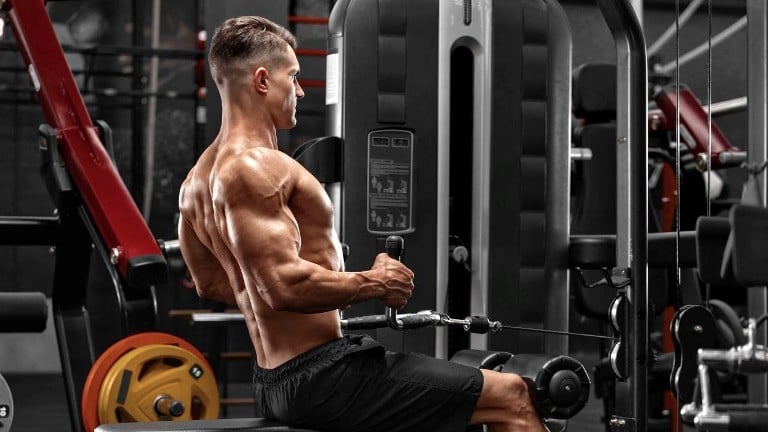
- 10 Best Cable Lower Back Exercises To Build Strength
- 1. Cable Deadlift
- 2. Seated Cable Row
- 3. Cable Wood Chop
- 4. Standing Low Cable Row
- 5. Cable Twist
- 6. Standing Cable Twisting Row
- 7. Cable Pull-Through
- 8. Stiff-Leg Cable Deadlift
- 9. Side Plank With Row
- 10. Pallof Press
- How to Strengthen Your Lower Back with Cable Exercises
- 1. Beginner’s Cable Workout Plan
- 2. Intermediate Workout Plan
- Anatomy Of Lower Back Muscles
- Erector Spinae
- Quadratus Lumborum
- Multifidus
- Latissimus Dorsi
- FAQs
- Are lower back cable exercises safe for beginners?
- How often should I do lower back cable exercises?
- Conclusion
10 Best Cable Lower Back Exercises To Build Strength
Here are the 10 best cable lower back exercises to help you build a stronger, healthier back.
1. Cable Deadlift
The cable deadlift is the best variation of the classic barbell deadlift and one of the best cable exercises for the lower back (posterior chain).
You can do the deadlift exercise using a barbell, a pair of dumbbells, and a cable.
One of the most significant benefits of using cable for deadlifts is that it offers a smooth, controlled motion, gives your muscles almost uninterrupted time under tension, and produces a massive pump—each of which can help optimize muscle growth.
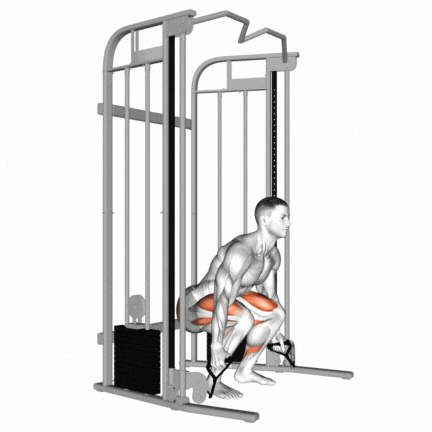
How To Do
- Attach two pulleys at the lowest setting on a cable machine.
- Make sure the cable pulley attachments are located close to each other.
- Hold on to the cable with each hand, you’ll lower your butt to the ground.
- Remember to keep your back as straight as possible. Contract your back and hamstrings.
- Raise the cable using your hamstrings and glutes.
- You should keep your legs slightly bent, your back straight, and your head looking up.
- Raise it to the point where your body is erect.
- Do not hyperextend your body as the weight shifts to the lumbar spine.
- Then, lower the cable slowly and steadily by bending at the hips and knees.
2. Seated Cable Row
Seated Cable Rows are an excellent cable exercise for building middle back muscles, and they also work on the lower back.
It focuses primarily on the muscles in your back, including the latissimus dorsi, rhomboids, and trapezius. It also engages your biceps and forearms as secondary muscles.
This back exercise is done on a cable rowing machine with separate handles, grip position change, and muscle work involvement.
- A pronated (overhand) grip targets the upper and middle trapezius.
- A neutral (thumbs up) grip hits the middle and lower trapezius.
- The supinated (underhand) grip switches the focus to the latissimus dorsi.
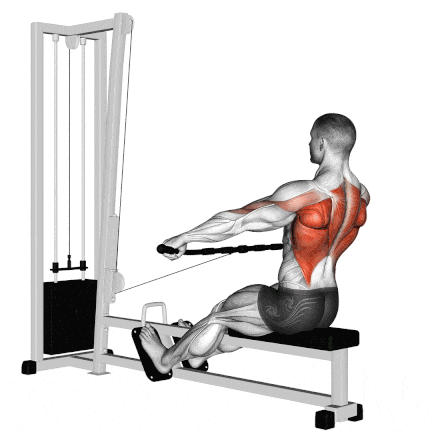
How To Do
- Sit down on the machine and place your feet on the footrests.
- Keep your knees slightly bent to avoid knee and lower back pressure.
- Grab the V-bar or wide-grip handle and sit back with extended arms.
- Keep your spine neutral and engage your core.
- Pull the cable towards your body, squeezing your shoulder blades together.
- Ensure your elbows are close to your body to maximize back muscle engagement.
- Hold for a second, then slowly release the cable to the starting position.
3. Cable Wood Chop
You can easily incorporate cable wood chop exercises into your back workout routine to build strength in your core muscles, including your lower back, abs, oblique, and hip muscles.
The cable wood chop is an exercise that utilizes a cable machine to evoke the action of chopping wood, thereby enhancing strength and power in the low cable, core and obliques.
This is great for strengthening the torso’s twisting movement pattern and improving its ability to resist twisting forces.
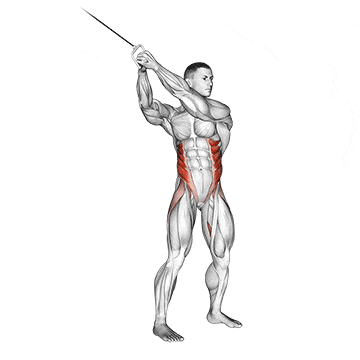
How To Do
- Attach a handle to the top of the cable pulley.
- Stand sideways to the machine, feet shoulder-width apart.
- Hold the handle with both hands and hold it up over your shoulder (Begin with a lighter weight).
- Grasp the cable handle with both hands and pull it across your body diagonally.
- Don’t lock the knees and hips. Allow the hips and knees to rotate slightly.
- Ensure that the movement is driven by your core and hips, rather than your arms.
- Pause at the top of each movement for a second, then slowly return to the starting position.
- Repeat the exercise on your opposite side.
4. Standing Low Cable Row
The low cable row is an upper-body exercise that primarily targets the back muscles, including the latissimus dorsi, rhomboids, trapezius, and rear deltoids. It also works on the arms and shoulders and strengthens the lower back and core.
The low cable row can be performed in different grip positions and attachments. Experiment with varying variations of grip, such as:
- Single-arm cable row
- Wide grip
- Underhand grip
- Long bar… Get creative!
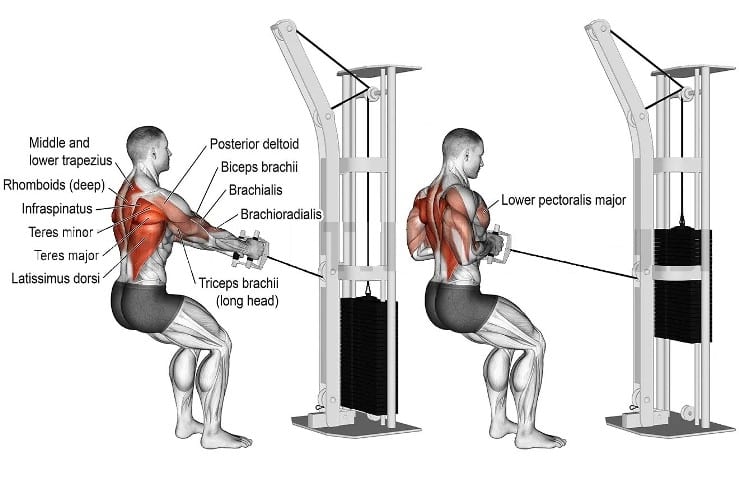
How To Do
- Stand in front of a cable machine with the pulley set at the lowest level.
- Stand about 2-3 feet away from the pulley.
- Bend slightly at the knees and waist to help stabilize yourself.
- Retract and squeeze your shoulder blades together.
- Pull the handle towards your abs and squeeze your shoulders together.
- After a moment, slowly return the handle to its original position.
- Keep your back straight at all times, and avoid using momentum.
Know More: Guide To Mastering The Cable Row: Benefits, Form, Variations
5. Cable Twist
The Cable Twist is a powerful core workout targeting the obliques, rectus abdominis, and lower back. It is a unilateral exercise, meaning it works independently on each side of your body.
This motion improves rotational power, which benefits athletes in sports like golf, baseball, and martial arts.
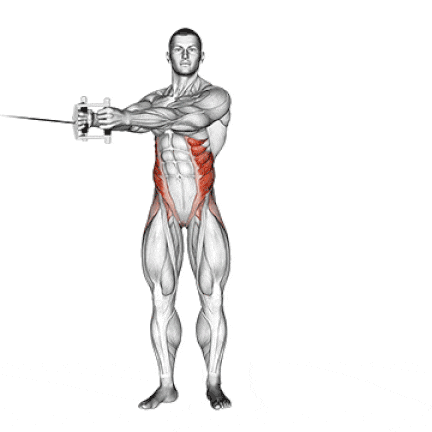
How To Do
- Adjust the cable machine so that the pulley is at chest height.
- Stand sideways to the cable machine, about arm’s length away.
- Grasp the cable handle with both hands, arms fully extended.
- Attach a handle to a shoulder-height cable pulley. Grasp the handle with both hands, either with your fingers interlaced or with one hand over the other. Stand next to the machine with your feet shoulder-width apart.
- Pull the handle, twisting it across your body to the opposite side. The rotation should come from the torso, not the arms.
- Hold for a count of two. Then, slowly reverse the movement to return to the starting position.
- Repeat the prescribed number of times. Repeat the exercise on your opposite side.
6. Standing Cable Twisting Row
The Standing Cable Twisting Row is a compound exercise combining traditional row and rotational core movement elements.
This powerful movement targets the back muscles, including the latissimus dorsi and rhomboids, while also working the obliques, biceps, and deltoids. Besides being a great back exercise, it also works your hips, glutes, and other lower body muscles.
You can use this same exercise with different hand placements to target upper or lower back muscles.
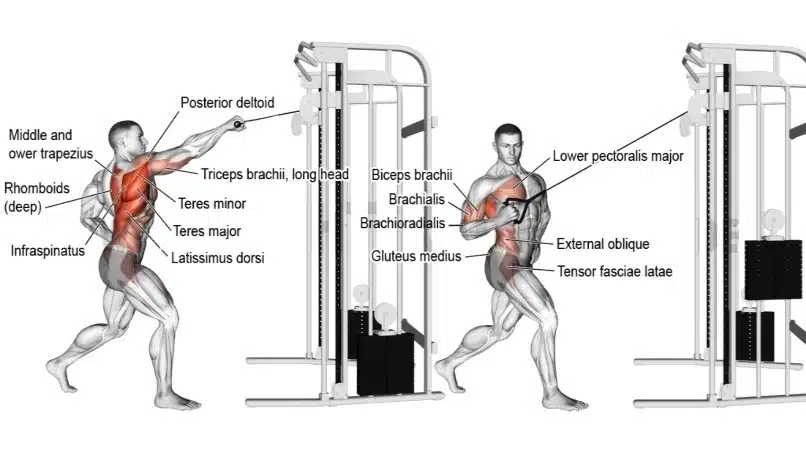
How To Do
- Attach a single grip handle to a high cable pulley.
- Step back and get into a staggered stance, knees slightly bent.
- Your arm should be out straight, and your waist should be rotated towards the cable.
- You can place your inactive hand on your other hip for added stability.
- Keep your elbow close to your body, pull the handle towards your waist, and rotate your waist in the same direction.
- Make sure the rotation is in your waist, not hips.
- Pause briefly at the top of the movement, then slowly return to the starting position.
7. Cable Pull-Through
The cable pull-through is a compound exercise that targets the posterior chain muscles, including the hamstrings, glutes, and lower back.
One of the best exercises to learn glute activation is this variation of the deadlift, which is an excellent introductory variation to the deadlift.
Many people don’t want to do this movement because it requires some preparation and might look funny.
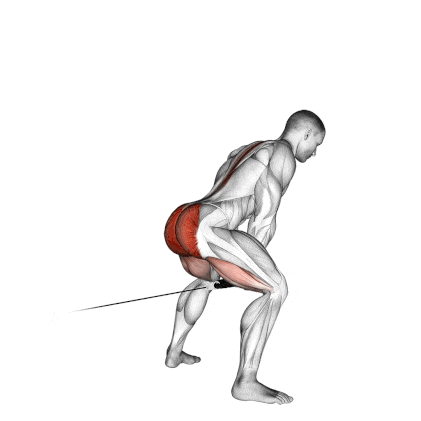
How To Do
- Attach cable low and stand facing away from the machine.
- Take a step forward until the rope is pulled tight. Stand with your feet shoulder-width apart.
- Maintain a straight posture, exhale as you rise and pull the cable attachment through your legs.
- The power for this exercise should come from your hips, not your arms or lower back.
- Pause for a second at the top of the movement. At the top of the movement, do not hyperextend your back.
- Then, slowly return to the starting position.
8. Stiff-Leg Cable Deadlift
If you’re looking for a straightforward cable lower back workout to build mass and strength, then cable stiff leg deadlift is a great staple exercise to get you started.
The cable stiff-leg deadlift for hamstrings requires a lighter weight than that used during traditional powerlifting for strengthening the lower back.
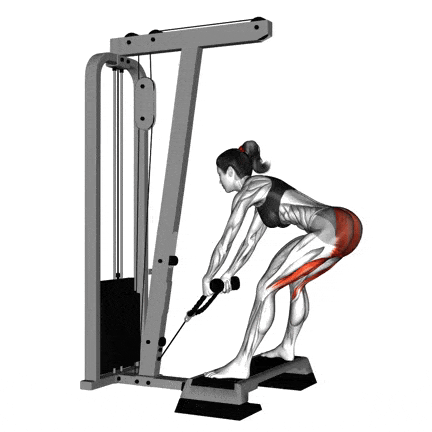
How To Do
- Attach the rope handle to the pulley and position at the lowest position.
- Face the pulley with the rope in both hands and about 3 feet of distance between you and the machine.
- Keeping your back straight, head up, and hips low, lift the cable into a standing position.
- Flex your knees a little and push your hips backward and slowly lower the cable down the front of your legs.
- Descend until you feel a mild stretch in your hamstrings.
- Exhale as you pull the cable back up to the starting position by pushing your hips forward.
- Repeat for the desired number of reps.
9. Side Plank With Row
The Side Plank with Row is a hybrid exercise that combines a side plank’s stability challenges with a row’s muscle engagement. This unique blend creates a compound exercise that works the lower back muscles, obliques, lats, rhomboids, and even the shoulders.
- The side plank element helps improve balance and postural support.
- The rowing part strengthens the lats and rhomboids, which are important for a strong back.
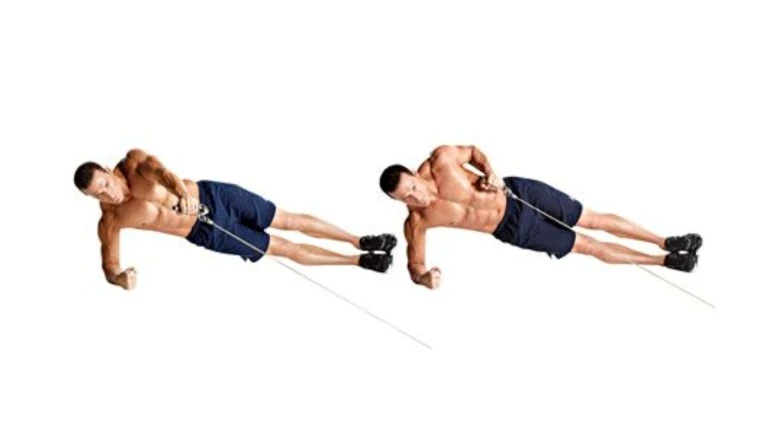
How To Do
- Use a cable machine and attach a handle to the low pulley with your left hand.
- Brace your core and raise your body into a side plank on your right side. Avoid sagging hips or drooping shoulders.
- Bend your left elbow and pull the handle to your rib cage. Perform the row in a slow, controlled manner.
- Hold for a second, then slowly release the weight to the starting position.
- Complete all reps on your left side, then switch to your right side and repeat.
Know More: Side Plank: Benefits, Variations, Muscles Used, Tips
10. Pallof Press
The Pallof Press is a full-body exercise that can increase overall stability and activate many large muscle groups.
It is an anti-rotation hold exercise to help you develop a stable core. It is a safe option for those with back issues because it minimizes strain on the lower back.
The Pallof press is a core strengthening exercise that helps establish proper spinal alignment under load and increases core stability.
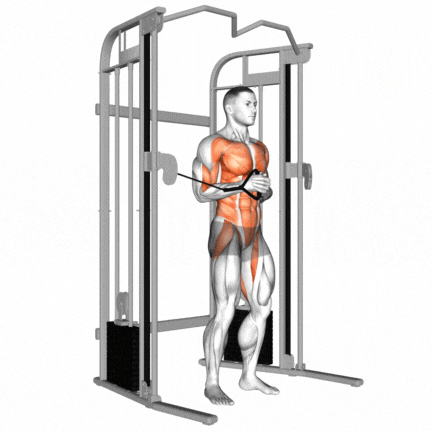
How To Do
- Attach a handle to a chest-high cable pulley.
- Stand on the side cable machine with your feet shoulder-width apart.
- Hold the handle or band close to your chest, with your hands centered on your body.
- Engage your core and push the handle out, allowing your arms to be fully extended in front of you.
- Hold for a second, then slowly release the cable or band back to the starting position.
- Repeat the exercise on your opposite side.
How to Strengthen Your Lower Back with Cable Exercises
Cable machines allow you to target all areas of the back muscles from multiple angles and through a full range of motion.
To structure an effective lower back workout on cable machines for building strength and mass, the number of reps and sets will depend on your current fitness level, workout frequency, and goals.
- For muscular endurance, higher reps (15-20) and moderate weights (50-70% 1RM) are recommended.
- For pure strength gains, do 4 to 6 sets of 1 to 6 reps for each exercise, using a weight of at least 85% of your one-repetition maximum (1RM). The lower the reps, the closer to 100% 1RM you should aim.
- If your priority is hypertrophy (muscle growth), perform 3 sets of 8 to 12 reps per exercise, with loads between 70-85% of your 1RM.
The above cable-only workout routine focuses on enhancing the hypertrophy and strength of your lower back.
1. Beginner’s Cable Workout Plan
Frequency: 2-3 times a week
| Exercise | Sets | Reps |
|---|---|---|
| Cable Deadlifts | 3 | 8-10 |
| Seated Cable Rows | 3 | 8-10 |
| Cable Pull-Throughs | 3 | 8-10 |
| Standing Cable Twisting Row | 3 | 8 per side |
2. Intermediate Workout Plan
The intermediate plan adds more sets and complicated exercises to the basic plan. This routine is meant to strengthen those who have already been working on their lower back.
| Exercise | Sets | Reps |
|---|---|---|
| Cable Deadlifts | 4 | 12 |
| Cable Romanian Deadlift | 3 | 12 |
| Seated Cable Rows | 4 | 12 |
| Cable Wood Chop | 3 | 20 swings |
| Cable Pallof Press | 3 | 15 |
Anatomy Of Lower Back Muscles
The lower back is more than just a single muscle; it’s a complex system of interconnected muscles, tendons, and ligaments.
Two of the most prominent lower back muscle groups worth highlighting are the Erector Spinae and the Quadratus Lumborum.
This complex network of muscles that work together to support the spine, bend and twist the torso, and move the legs.
Erector Spinae
The Erector Spinae is not a single muscle, but a group of muscles and tendons that run parallel to the spin.e. These muscles extend from the lower back to the upper neck.
It is divided into three parts: the spinalis, iliocostalis, and longissimus. The erector spinae muscles help to extend the spine and to keep it upright.
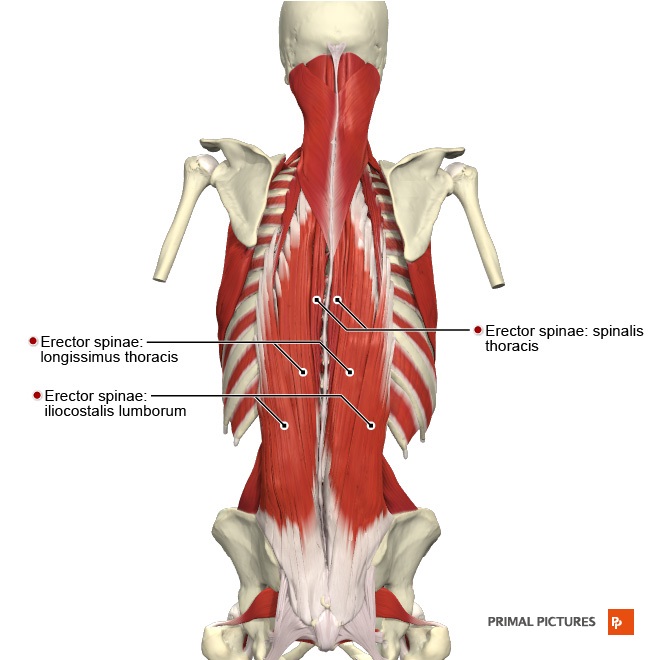
Quadratus Lumborum
The Quadratus Lumborum is a deep muscle that originates in the hip and attaches to the lower ribs and the lumbar spine.
This muscle is crucial for spinal stabilization and is heavily engaged in activities that require side-bending or hip hiking. It’s often overlooked, but is vitally important for maintaining a healthy lower back and core.
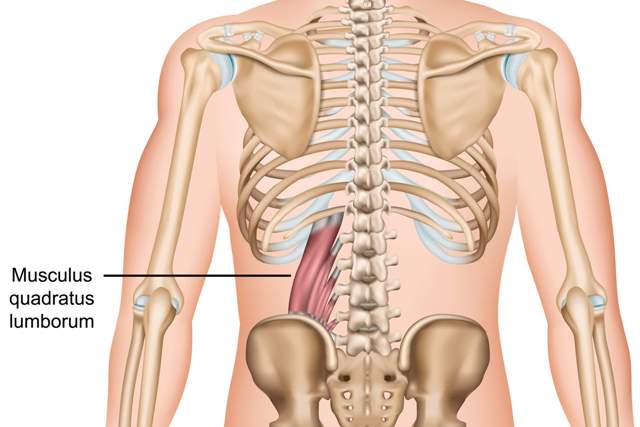
Multifidus
This muscle is located deep in the lower back and runs along each side of the spine. It helps to stabilize the spine and to prevent it from moving too much.
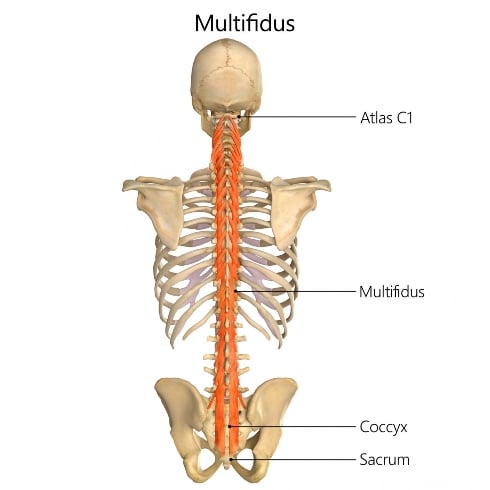
Latissimus Dorsi
This muscle is located in the upper back and extends down to the lower back. It helps to extend the spine and to pull the arms down towards the body.
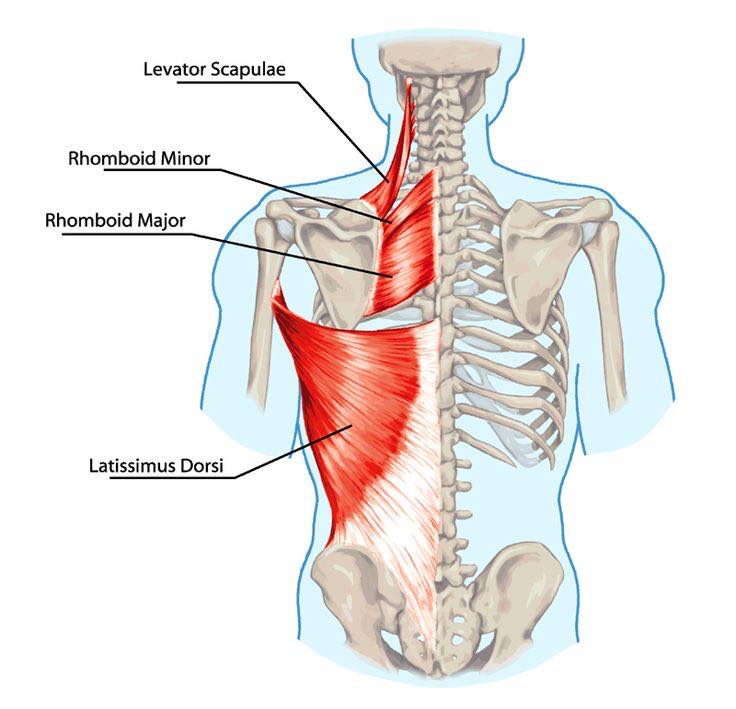
These are just some of the many muscles that make up the lower back.
FAQs
Are lower back cable exercises safe for beginners?
Yes, lower back cable exercises can be safe for beginners. Cable machines provide controlled movement, which makes it easier to maintain good form. However, it is important to start with lighter weights and aim for higher repetitions to get used to the exercise before moving on to heavier weights.
How often should I do lower back cable exercises?
Do lower back cable exercises 2-3 times a week to get the best results. Make sure to allow sufficient rest and recovery between workouts.
Conclusion
Adding lower back cable exercises to your workout routine can help you build a stronger, healthier back. Cable machines are designed to provide even and constant muscle tension while executing each exercise, which helps keep your muscles engaged throughout the entire range of motion.
Various exercises, such as the seated cable row, standing cable row, cable deadlift, cable pull-through, and cable twist, can target all areas of your back muscles.
These exercises not only help build and tone muscles, but they also help improve posture, balance, and daily functionality.
References
- James Rainville, Carol Hartigan, Eugenio Martinez, Janet Limke, Cristin Jouve, Mark Finno: Exercise as a treatment for chronic low back pain. PMID: 14749199 DOI: 10.1016/s1529-9430(03)00174-8
- Rahman Shiri, David Coggon: Exercise for the Prevention of Low Back Pain: Systematic Review and Meta-Analysis of Controlled Trials: American Journal of Epidemiology, Volume 187, Issue 5, May 2018, Pages 1093–1101
- Suh, Jee Hyun MD; Kim, Hayoung BS; Jung, Gwang Pyo MD; Ko, Jin Young MD; Ryu, Ju Seok MD, PhD: The effect of lumbar stabilization and walking exercises on chronic low back pain: June 2019 – Volume 98 – Issue 26 – p e16173 doi: 10.1097/MD.0000000000016173
- Hartigan C. Exercise-based therapy for low back pain. https://www.uptodate.com/contents/search. Accessed April 19, 2023.

Manish is a NASM-certified fitness and nutrition coach with over 10 years of experience in weight lifting and fat loss fitness coaching. He specializes in gym-based training and has a lot of knowledge about exercise, lifting technique, biomechanics, and more.
Through “Fit Life Regime,” he generously shares the insights he’s gained over a decade in the field. His goal is to equip others with the knowledge to start their own fitness journey.
